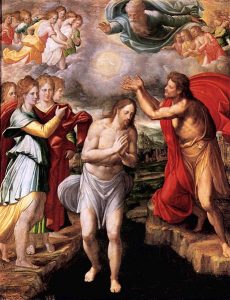It is a great error within Christianity to limit the graces and meditations of the Rosary to only Catholicism. While other denominations may be swayed away due to false prejudices against Catholicism or a fear of fictitious Marian worship, the reality is the Rosary is a Biblical prayer that looks to bring individuals closer to Christ. Through the meditations of the rosary and its powerful prayers, individuals can walk the life of Christ.
What the life of Christ teaches humanity is about love of God and neighbor. Through the sacred mysteries of the Rosary, one is introduced to the life of Christ, from His birth to His death and to His Resurrection. The life teaches humanity of the pilgrim journey on Earth and the ultimate union with God in heaven. It teaches humanity the difficulties of life and the remedies for those difficulties. In this way, the Rosary is a map of the life of Christ through Mary and a guide to life’s issues. By utilizing Christ and His mother as examples, Christians can learn how to carry their own crosses in this world.
It is critical hence to understand that the Rosary is a Biblical prayer. Many non Catholics may be astonished to hear this, but the reality is most of the mysteries of the Rosary are based upon Scripture itself. In all, there are Four categories of mysteries. The Joyful, the Illuminous, the Sorrowful and the Glorious. The original three mysteries date back to St Dominic in the 13th Century. Tradition states, he received instructions upon the mysteries in a vision from the Blessed Mother. The Illuminous mysteries were later added recently by Pope John Paul the II.
The mysteries themselves are primarily scripturally based. During the recitation of each set of mysteries, Christians are told to meditate upon the story and relate it to their own life. We will first look at the Joyful Mysteries.
Joyful Mysteries

The First Joyful Mystery is the Annunciation. (Luke 1: 26-38; John 1:14). This mystery teaches one the humility of Mary and how one can emulate that humility as well as complete obedience to the will of God as Mary accepted the Incarnation of Christ within her womb.
The Second Joyful Mystery is the Vistitation. (Luke 1:39-56). This mystery teaches love and compassion of neighbor. Mary visited her cousin Elizabeth and the babe in Elizabeth’s womb lept at the coming of Christ in Mary.
The Third Joyful Mystery is the Nativity. (Luke 2: 6-20; Matthew 1:18-25). This mystery teaches poverty. Our Lord came into this world poor and taught the value of poverty and simplicity. It also teaches one of the extreme love of Christ for the world to become human.
The Fourth Joyful Mystery is the Presentation into the Temple. (Luke 2:22-39). This mystery teaches how Joseph and Mary kept obedience to the Old Law and presented Christ in the Temple as Jewish custom commanded.
The Fifth Joyful Mystery is the Finding of Jesus in the Temple. (Luke 2:41-51) This mystery teaches the wisdom of Jesus and also the joy in finding Jesus. Joseph and Mary were terrified losing Jesus and frantically returned to Jerusalem to find Him.
Illuminous Mysteries

The First Illuminous Mystery is the Baptism of Jesus. (Matthew 3:11-17; Mark 1:9-11; Luke 3: 15-22; John 1:26-34). This mystery teaches the importance of Baptism and also the manifestation of the Trinity. Jesus again shows obedience to His Father in Heaven.
The Second Illuminous Mystery is the Wedding Feast at Cana. (John 2: 1-12) This mystery shows Mary’s faith in Jesus and also her maternal care to go to Jesus when we are in need.
The Third Illuminous Mystery is the Proclamation of the Kingdom. (Mark 1:14-15; Matthew 5:1-16; Matthew 6:33; Matthew 7:21). This mystery teaches the conversion of heart. In it one may reflect on the wisdom of Christ and His many proclamations to the crowds that stood before Him.
The Fourth Illuminous Mystery is the Transfiguration. (Matthew 17:1-8; Mark 9: 2-10; Luke 9:28-36). This mystery shows the manifestation of Christ as God, as both Moses and Abraham bow before Him. Peter, James and John witnessed this extraordinary event.
The Fifth Illuminous Mystery is the Last Supper. (Matthew 26:26-28; Mark 22-25; Luke 22:14-20; John 6:33-59). This mystery presents the institution of the Eucharist and the importance of Christian worship through the celebration of the Eucharist.
The Sorrowful Mysteries

The First Sorrowful Mystery is the Agony in the Garden. (Matthew 26:26-46; Mark 14:32-42; Luke 22:39-46.) This mystery teaches the pain of sin and Christ’s offering of His will to the Father even till death. Christ accepts suffering and death for humanity.
The Second Sorrowful Mystery is the Scourging of the Pillar. (Matthew 27:26; Mark 15: 15; Luke 23:16-23; John 19:1). This mystery reveals the suffering of Christ as He was cruelly whipped. It teaches us the sting of sin as it whipped our Precious Lord. The self denial of Christ to permit this, His love of humanity are all on display
The Third Sorrowful Mystery is the Crowning of Thorns. (Matthew 27:29-30; Mark 15:16; John 19:2-3). This mystery displays the mockery of Christ and how He patiently endured it for our sins. It shows Christ’s moral courage and love of one’s enemies.
The Fourth Sorrowful Mystery is the Carrying of the Cross. ( Luke 23:26-32; Matthew 27:31-32; Mark 15:21). This mystery shows the moral fortitude of Christ to carry the sin of the world. It teaches Christ’s patience and love for humanity. Christ serves as an example for ourselves to carry our own crosses.
The Fifth Sorrowful Mystery is the Crucifixion. (Luke 23:33-46; Mark 15:22-39; Matthew 27:33-54; John 19:17-37). This mystery shows the full pain of sin and the sacrifice of Christ for us on the cross. It shows God’s mercy and the terrible price for sin.
The Glorious Mysteries

The First Glorious Mystery is the Resurrection. (Mathew 28: 1-10). Mark 16: 1-18; Luke 24: 1-49; John 20:1-29). This mystery displays Christ’s victory over sin and His divinity. It teaches that Christ conquered death through death and the value of suffering. It teaches that all who die with Christ will rise with Him. It displays the faith rewarded.
The Second Glorious Mystery is the Ascension. (Mark 16: 19-20; Luke 24:50-51; Acts 1:6-11. This mystery illustrates Christ’s ascension into Heaven. It teaches us the necessity of hope for our future reunion with Christ.
The Third Glorious Mystery is the Decent of the Holy Spirit Upon the Apostles and Our Lady. (Acts 2:1-41). This mystery shows the love and sanctification of the Holy Spirit. Through Christ’s death, the Holy Spirit gives Christians the grace and gifts to serve the Church on earth.
The Fourth Glorious Mystery is the Assumption. This mystery is not found in Scripture but in tradition but it does allude to ultimate gift all Christians will receive on the day of the General Resurrection
The Fifth Glorious Mystery is the Coronation. This mystery is not found in Scripture but alluded to in Revelation. It shows Mary receiving her rightful place next to her Son in Heaven.
Prayers within the Rosary
Most of the prayers within the Rosary are also biblical. Within the decades, each begin with an Our Father and ten Hail Mary prayers. The Our Father came to humanity directly from Christ Himself as found in the Gospels and the words of the Hail Mary are a compilation of the words of the Angel Gabriel and Elizabeth found in the Gospels. The other prayers are early prayers found within the Christian community.
Commentary

From these mysteries and prayers, one can see that the Rosary is primarily a Scriptural prayer. It can be utilized by both Catholic and non Catholic alike without any deviation from each other’s faith. Aside from the final two Marian Mysteries found in the Glorious Mysteries, there is no room for theological debate. The mysteries teach about the life of Christ and how one can follow the example of Christ in their own life. It is due to this that the Rosary is an excellent source of meditation for counseling.
Individuals can find many moral stories to emulate in their own daily struggles. Whether it is accepting suffering, the will of God, or carrying one’s cross, one can view the mysteries and find examples of how to properly behave within a Christian life. The Rosary guides one through the good times and bad times of life and again shows the promise of a glorious life in Heaven with Christ. These meditations can instill hope for individuals who have very little in this life.
In addition, according to Catholic tradition, it serves as powerful prayer for world peace, as depicted by Our Lady of Fatima in 1917, when she asked the three children to pray the Rosary daily for the conversion of sinners and peace in the world.
I hope this serves not as a call to one denomination of Christianity over the other but a call to viewing the Rosary as a universal prayer for all Christians to utilize in their spiritual life. While it may not be found as a form of prayer directly accounted for in Scripture, it does not necessarily mean it does not evolve from Scripture.
When the Rosary can become less productive in spiritual life is when merely recites the words without true meditation. Christ warns against repetitious prayer without thought. There is far more value in intimate prayer. If one has difficulty with focus, then merely say one decade.
Many fears of non Catholics regarding the Rosary is the fictitious idea that is promotes Marian worship which is false. The other fear is that one is praying for another to intercede. Christ alone stands before the Father as High Priest, however, the prayers in the Rosary while Biblical, also invoke others to pray for humanity, such as Mary, the Archangel Michael, etc. The reality is the prayer of the Rosary asks Mary and the saints to take our petitions, that we pray directly, and also ask for them to take as well, to Christ. Christ is the High Priest and the Rosary in no way teaches that there are alternate routes. Many of the prayers are directly to Christ or focus directly on Christ’s life.
Some Christians may find this acceptable and others may never. Different traditions value different types of prayer. This is merely a look at the Rosary as a possible spirituality for some and for others in counseling. It is far from non Christian and can be utilized but it will vary from Christian to Christian.
Please also review AIHCP’s Christian Counseling Certification and see if it meets your academic and professional goals. The program is online and independent study and open to qualified professionals seeking a four year certification as a Christian Counselor.
Additional Resources
“MYSTERIES OF THE ROSARY IN THE BIBLE”. Peggy Bowes. May 11, 2011.Prayer / Spiritual Life. Access here
“The History of the Rosary”. Sister Mary Peter. July 26th, 2008. Catholicism.org. Access here
“The rosary: common myths and facts”. Edie Heipel. Washington, D.C. Newsroom, Oct 1, 2022. Catholic News Agency. Access here
“The Story of Fatima”. The World Apostolate of Fatima. Access here
